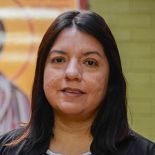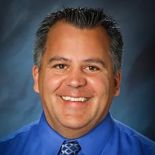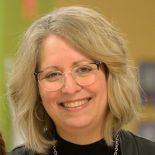Hurdles, Advice, and Creative Solutions: Principals’ Reflections and Insights on Reopening

As Catholic schools plan, evaluate, and sometimes reevaluate their opening plans and protocols, school leaders are called to be innovative and resourceful in an effort to keep their students and families safe, healthy, learning, and hopeful.
The CSA team commends all leaders on the heroic efforts being conducted, and we interviewed four former Latino Enrollment Institute (LEI) school leaders regarding the start to the year, with a particular focus on ensuring their schools are a safe haven for students. The schools featured represent a cross-section of the country in terms of geography, grade-levels served, and in program offerings - in person, hybrid, and virtual learning.
We are grateful to the following leaders for their insights and wisdom shared.
-
Kristy Dunn | Principal, St. Theresa Catholic School
Little Rock, Arkansas
St. Theresa has begun the year with a hybrid model in which PK attends school daily, K-8 attends school two days a week in shifts, and the other three days a week are virtual. St. Theresa began the LEI with 159 total students, 69 of which were Latino. The school now boasts a total enrollment of 228 students with 198 Latinos served, representing 87% of the school population. -
Alicia Vazquez | Principal, St. James Catholic School
Oklahoma City, Oklahoma
St. James provides in-person learning for grades PK-8. St. James started their LEI experience with 175 students, 76 students identifying as Latino. Currently the school serves 190 students with 79% or 150 Latino students. -
Ted Kanelopoulos | Principal, La Salle High School
Union Gap, Washington
La Salle High School is currently providing both a virtual and in-person learning experience. La Salle has enrolled 82 Latino students in recent years, resulting in a 36% increase in Latino enrollment. The total enrollment in the school has grown from 206 to 229. -
Crystal Blahnik | Principal, St. Bernard Catholic School
Green Bay, Wisconsin
St. Bernard belongs to the GRACE system of schools, and they offer a GRACE Virtual Academy for students who need or would like to learn virtually this school year. The nine GRACE schools are opening face to face and those who choose to attend virtually become participants in the GRACE Virtual Academy while continuing to be members of our site-based school community. Students are able to move in and out of the GVA at the trimester break in November and February. Enrollment began at 407 for St. Bernard, with 56 Latino students. Currently, enrollment is 507 with 238 Latino students representing 47% of the school population.
What was the one biggest hurdle you faced in reopening your school?
- Kristy Dunn:
Getting enough technology is still the biggest hurdle -- we still don't have the Chromebooks we ordered in June or the Lysol spray we ordered in August. However, the Holy Spirit has been working hard to get us all the things we need through donors and partner businesses. - Alicia Vazquez:
One of the biggest hurdles that we faced was the elearning for our Hispanic families. First, we do not have Chrome books, and a lot of our families do not have enough educational background to help their children; therefore they struggled when they had to explain the assignments that were done in packets. - Ted Kanelopoulos:
The biggest challenge was the actual planning for our reopening. It was not clear whether we would be allowed to open until a week before our scheduled start of school. The guidance coming from the CDC, state agencies, and our regional health district was often inconsistent and sometimes even conflicting! Navigating this has been a challenge. - Crystal Blahnik:
The biggest challenge we faced in preparing to open was the reconfiguration of our classrooms and learning spaces. With classrooms of 25+ students, every inch matters. Classrooms were reconfigured from flexible learning spaces with seating choices and learning centers to traditional rows of desks spread out as much as humanly possible. In order to make this happen, we had 200 old desks brought up from our storage rooms and we moved all extra furniture from our classrooms into off-site storage. Additionally, with 500 children on site, we paid special attention to the lunchroom. Plexiglass cubicles in the lunchroom have allowed us to keep the emphasis on community and socialization while maintaining health and safety protocols.
As you have started the year, can you describe two ways in which you have attended to parent concerns and built support?
- Kristy Dunn:
Zoom, zoom, and more zoom! We are meeting with parents virtually or in-person more than ever to strengthen those bonds that may feel weakened due to temporary closure and distance.
Parent ambassadors called nearly every family this summer, and it's on the agenda for them to do so again in the next two weeks. Our assistant principal has also written notes to all families new to our school.
Communication is more important than ever before. - Alicia Vazquez:
Being available for parents has been something that we have made sure to do, from translating to filling out forms for assistance. Another thing that we have done is to implement many procedures to assure that our students are safe at school. - Ted Kanelopoulos:
The biggest challenge was the actual planning for our reopening. It was not clear whether we would be allowed to open until a week before our scheduled start of school. The guidance coming from the CDC, state agencies, and our regional health district was often inconsistent and sometimes even conflicting! Navigating this has been a challenge.: Ensuring regular communication with our parent community has been essential. To build parent confidence in our plan for in-person instruction, we shared our Safe Reopening Plan. This plan outlines the many health and safety protocols we are implementing on campus and our response and communication plan in the event of a Covid-19 case on campus or possible close contact.
Additionally, our faculty made a commitment to offer both in-person and remote instruction to students concurrently. We wanted to ensure families who had students or family members with underlying health concerns who were anxious about returning to campus for any reason that they had an option to continue school at La Salle remotely. - Crystal Blahnik:
We knew it was going to be vital to have high-quality communication with our parents about our plans for reopening. In light of this, we had a committee of stakeholders work on a reentry plan through the summer months. As we got into the month of August, our system leadership team was able to have our school reopening plan evaluated by our local health consultant as well as our representative from the county health department. These extra layers of support and expertise allowed for a deep level of confidence for both my faculty as well as my parent community.
Once our plans were solidified, I shared them with my parent community in their home languages. Before school began we held a series of live, online meetings with our families so that we could share our plans and address their questions and concerns. Additionally, we took an extra step and created a simple presentation - a five-step process for keeping students safe and healthy here at school. This presentation was also provided in our families' home language.
Now that you have restarted, what advice would you share with other princpals?
- Kristy Dunn:
I would say to tune in to the needs of your community, speak to your community, and develop a plan that works for your community. Your plan may be different than other schools' plans...and that's okay! - Alicia Vazquez:
It takes a lot of planning to run a virus-free (as much as humanly possible) school but with the support of your staff, pastor, and diocese you can do it. Take care of yourself and remember to reach out for help. Delegating things is very important and we have to make sure we let others help. - Ted Kanelopoulos:
I would highly recommend adopting an online health screening process to expedite the process of checking staff and students into school each day.
I would proactively plan and schedule community events that are Covid-19 safe that allow for students to build and celebrate community. The school day in the Covid-19 environment can be very regimented. The loss of extra-curricular activities makes things especially challenging.
I would set the health and safety standards high for your school community. Teachers and students want to be in school and are willing to do their part (mask wearing, social distancing, disinfecting, etc.) to keep everyone at school. Student cooperation has exceeded my expectations. - Crystal Blahnik:
Be Flexible. Stay Positive. Expect the Unexpected. Have an Attitude of Gratitude.
Everyone in the building has to be in the frame of mind that this is a year like none we have faced in our generation and that flexibility will be the key to success. In my building, it is all hands on deck in every aspect of the building operations. You might be our reading interventionist, but if we are short-handed and we need to get the lunchroom sanitized and ready for the next group of students, then that is where we will need you to be. Each day has been different since we opened our doors for in-person learning on August 28th and I expect that, for now, unpredictability will be our new reality. Especially important, for me, is to be grateful for each and every hour of the day. The blessings are found in the little things - a colleague who lent a hand, a nice note from a parent, a sunny morning, etc. There are always things to be thankful for - it is not all bad. Your frame of mind is contagious, so it might as well be a positive one!
What is the most creative thing you have implemented during this time to safely serve students and families?
- Kristy Dunn:
We have a YouTube channel and we have made videos about everything from how to drop off your kids for temperature checks to what your teacher may look like wearing a mask. Currently, we upload a video a week on a reflection from the book Oh, for Heaven's Sake by Father John K. Antony, alumnus. We have reflections from adults and kids and prompts for families to discuss at home. - Alicia Vazquez:
One thing I have done is call every family personally and have listened to their concerns about things and have taken it and implemented it in our school to assure families that we will be ok. - Ted Kanelopoulos:
With the help of our local Catholic Charities, we developed a health screening program that allows us to ensure all students, staff, and visitors answer health and symptoms questions before arriving on campus each day. - Crystal Blahnik:
One of the most creative things we did to make our building operational was to rearrange our entire drop off routine. We moved from one bus and one car drop-off from 8:15-8:30 to a total of four drop-off points that are now spread out from 8:00-8:30 am. This has allowed us to spread out the flow of students entering the hallways and classrooms, and given us the time we need to take temperatures and ask routine health questions while keeping our pods of students together to limit contact tracing. This was creative, but also a huge undertaking that ended up working out really well. We are also enjoying the added time we now have in the mornings to communicate with families at drop-off. We actually get that time to interact with them personally and that is just a really great way to start the day.
Describe one or two ways in which you have planned the start of the year accounting for the needs and strengths of Latino families.
- Kristy Dunn:
Communication with families is in both English and Spanish as often as possible. I am being intentionally aware of families' changing economic status, as jobs were impacted by COVID19. The strong community bonds serve us well during this time of distance learning; we still feel like our community even though we are not all gathered together like we were in the past. - Alicia Vazquez:
This year due to our budget we have worked with families and allowed them to enroll at a lower tuition rate than before. This in turn has actually helped our school to open our doors to other families to see what a Catholic school is all about and help with our budgeting to bring in something (in terms of tuition) rather than nothing. - Ted Kanelopoulos:
Many of our Latino families have been disproportionately affected by the pandemic. We have been able to substantially increase our food program to address an increase in food insecurity experienced by our Latino families.
Many of our Latino families live in more rural parts of our agricultural region where internet accessibility is not dependable. We have been able to provide school-issued hot spots to allow students to work remotely. - Crystal Blahnik:
All of our communication and programming is always presented in Spanish and English. To meet the needs of our families who are less comfortable with technology or who do not have access to the internet, we have made personal phone calls to each of those families. Getting the lines of communication open with our Latino families facilitates a parent-school partnership that ultimately benefits the academic success of their children. Something that has worked really well has been Google Meetings for our Spanish speaking families. We can answer questions in Spanish in the chat feature, or we can have a dialogue with them in Spanish through the video meeting.
Are you interested in joining an ever-growing network of Catholic school leaders like these four, as well as learn how your Catholic school can better reach out to and serve culturally and linguistically diverse students and families?
Consider joining the Latino Enrollment Institute!





